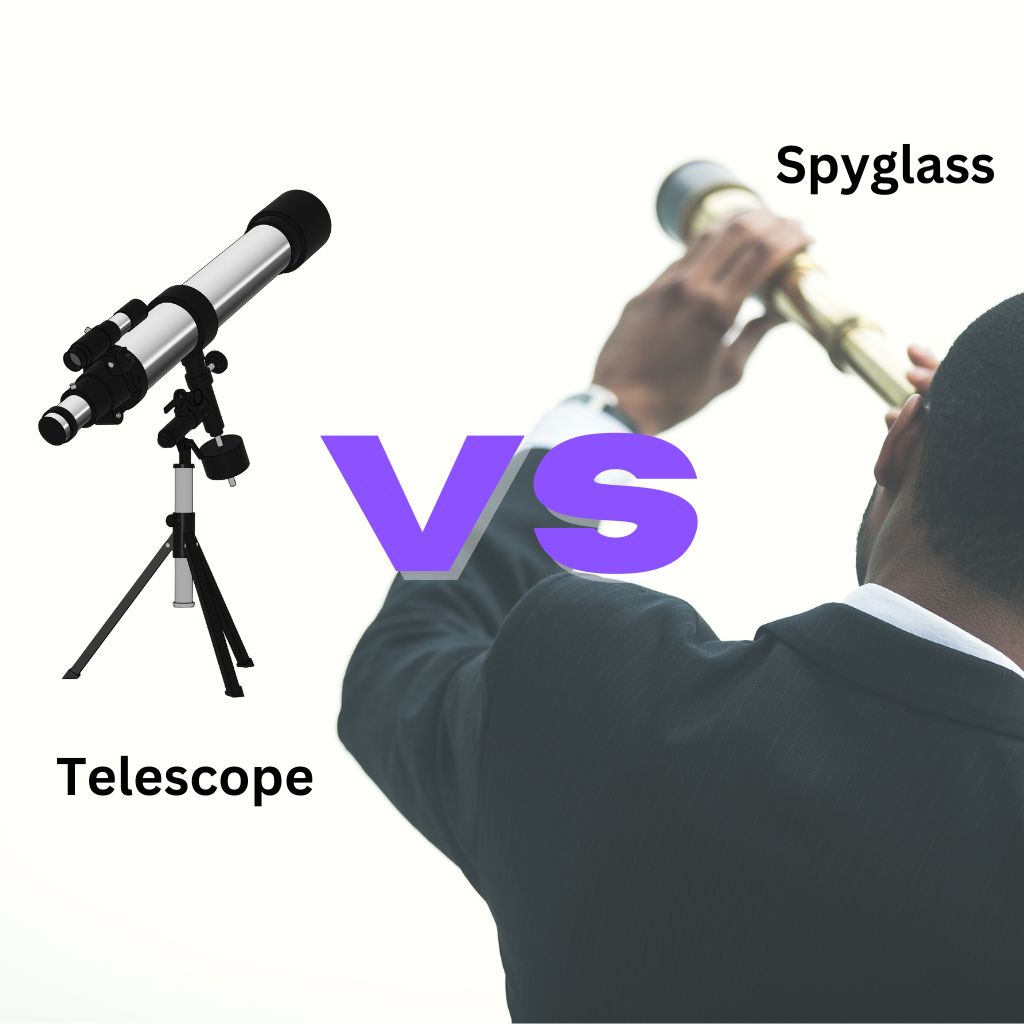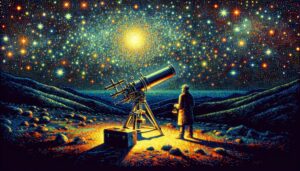This site contains affiliate links to products. I may receive a commission for purchases made through these links.
Spyglass and telescopes are often mistaken for each other, thanks to their similar functionality. But, they’re as different as chalk and cheese.
In essence, a telescope is a sophisticated piece of equipment used by astronomers to explore the vast universe. It’s designed to gather and magnify light from distant objects, making them appear closer. On the other hand, a spyglass or a handheld telescope, is a portable device often used by mariners and adventurers to observe distant objects on earth.
Understanding the difference between these two can be a game-changer, especially if you’re into astronomy or seafaring. So, let’s delve deeper and explore the unique characteristics, uses, and benefits of telescopes and spyglasses.
What is a Telescope?
If we were to journey through the cosmos, we’d need a sophisticated machine. A telescope is that machine. It’s a powerful, high-tech instrument that scientists use to observe objects beyond Earth, like distant galaxies, black holes, and nebulae.
But how does a telescope work? It comes down to a science known as optics. Simply put, telescopes gather light from a distant object and focus it to create an image. The larger a telescope’s lens or mirror, the higher its resolution and the better the detail it can detect.
Let’s break down the two main types of telescopes: refracting telescopes and reflecting telescopes.
- Refracting telescopes use glass lenses to bend (refract) light. When the light passes through a lens, it brings it to a single point of focus. The very first telescope invented by Galileo was a refractor.
- Reflecting telescopes, also known as Newtonian telescopes, utilize mirrors instead of lenses. The curved mirror in a reflector telescope collects light, then reflects it to a single point of focus.
Telescopes open a window into the stunning and mysterious cosmos. They provide us with breathtaking images of distant stars and galaxies, and critically support the ongoing exploration of space. Their intricate design and function make telescopes integral tools in astronomy.
What is a Spyglass?
Do not mistake the spyglass to be just a fancy name for telescope. In reality, a spyglass is a type of telescope – a much simpler one. When we think about telescopes, we conjure images of large, complex devices often used in astronomical observations. But in contrast, a spyglass usually brings up images of pirates peering through them in popular culture.
Essentially, a spyglass is a small, compact, handheld telescope. It’s designed with a singular purpose in mind: to magnify distant objects for the viewer on land or at sea. Historically they were used by sailors and explorers to scout out lands and other ships.
How does a spyglass work you might ask? It’s simple. A spyglass uses a process called refracting. This is where the lens bends light to create a magnified image of a far-off object. To sum it up, the spyglass brings distant objects closer to your eye.
While both telescopes and spyglasses make use of refracting techniques, their usage and structure are vastly different. Telescopes are more advanced, often using both refraction and reflection to provide clearer images of farther and celestial entities. Meanwhile, the spyglass’s rudimentary design makes it more suited for terrestrial, short-range usage.
It’s interesting to note how this tool has historically had significant maritime application. Sailors in the past relied on spyglasses for navigation and identifying threats. Even today, in its modern forms, the spyglass still holds its place in marine exploration and adventuring.
Key Differences between a Telescope and a Spyglass
As we dive deeper into the realm of observational tools, two standout entities are telescopes and spyglasses. Both were created with the objective of magnifying distant objects – a telescope enables us to gaze at the stars, while a spyglass helps to view closer, terrestrial items. Let’s dissect their differences a touch further.
Purpose and Usage
Despite the commonality of forming magnified images, the usage and functionality of telescopes and spyglasses differ significantly. Telescopes were designed specifically for astronomical purposes, allowing individuals to observe celestial entities. They’re typically sturdier, larger, and stationary. Spyglasses, on the other hand, were designed for terrestrial, everyday use especially by sailors and explorers in the past. Lightweight, portable and easily handheld, they’re still used today in marine exploration.
Construction and Design
While both the telescope and the spyglass use refracting techniques, their construction and design differ widely as per their usage. Telescopes are more elaborate, built with high-end glass lenses and mirrors that ensure maximum light collection and maximum clarity. Spyglasses are simpler, usually featuring a single or at most, two lens system. The material utilized is relatively less refined, focusing less on image quality and more on portability and convenience.
Magnifying Capabilities
In terms of magnifying capabilities, telescopes clearly outshine spyglasses. The power of a telescope to magnify celestial objects is far beyond what a spyglass can achieve. For a better understanding, let’s compare the capabilities in the table below:
| Attribute | Telescope | Spyglass |
|---|---|---|
| Max. Magnification | 500x | 20x |
| Focus Precision | High | Low |
In essence, while both instruments have stood the test of time and continue to serve their respective purposes: telescopes for detailed, deep sky observations and spyglasses for quick, handheld terrestrial observations. Understanding their key differences could pinpoint exactly which tool would serve your needs best.
Uses of Telescopes
Telescopes play an indispensable role in the exciting world of astronomy. It’s through these scientific instruments that we’ve uncovered some of the most eye-opening facts about our universe.
One primary use of telescopes is in stargazing. It’s no surprise that astronomers – both professional and amateur – rely heavily on them to get a closer look at celestial bodies. Whether it’s locating distant stars, observing nebulas, or marveling at galaxies far far away, telescopes have us covered.
Then there’s the pursuit of planetary exploration. Telescopes are a crucial tool for anyone curious to understand our solar system’s planets, moons, asteroids, and comets better. With the right telescope, you can even spot details of Mars’ landscape or the rings of Saturn.
But the use of telescopes doesn’t stop at exploring our own backyard – the Solar System. They are also used to tackle the big questions of cosmology. They enable scientists to study galaxies beyond our own, providing insights into the structure of the cosmos, the Big Bang theory, and the mysteries of dark matter and dark energy.
Let’s not forget about astro-photography. With today’s technological advancements, many telescopes can be attached to cameras, opening up a whole new world of capturing the ethereal beauty of what lies above us. Be it shooting the moon craters or capturing the radiant sunspots, an astro-photography setup can help you achieve that with ease.
Telescopes have utilizes beyond simple observation and study. Some telescopes, often found in observatories, are used for tracking space debris and satellites. This use helps ensure that equipment, space stations, or even astronauts in space are safe from potential collisions.
From opening the doors to the universe’s wonders to capturing celestial marvels, it’s clear that the uses of telescopes are vast and varied. No matter where your interest lies, there’s a telescope out there waiting to fuel your curiosity and enhance your exploration journey.
Uses of Spyglasses
Let’s shift the spotlight towards spyglasses now. Despite their smaller size and simpler construction, spyglasses have numerous applications in diverse fields. They’re not just relics of the past, but tools of practical use and fascinating instruments that captivate the imagination.
One of the primary uses of spyglasses is in navigation. Mariners and explorers have relied on these handy devices for centuries. Navigators utilize spyglasses to view long distances over the sea, establishing the presence of land or ships. These provide critical information during voyages, and aid mariners in plotting their path through endless oceans.
Spyglasses also find use in the military field. Officers use these to survey the battlefield, estimating enemy troop size and movements. Scoping out prospective dangers or threats, these devices become pivotal tools in strategizing and planning.
Yet another significant use stems from nature observation. Whether for bird watching, observing wild animals or getting a closer look at the beauty of landscapes, a spyglass enriches the experience. It brings users closer to nature without causing disruption or intruding on wildlife.
Lastly, let’s not overlook the hobby aspect. A spyglass can enhance a simple hiking or camping trip. Imagine the joy in viewing a distant waterfall or spotting rare wildlife without leaving your campsite. These devices also contribute to educational activities, stirring curiosity and encouraging exploration among young minds.
So, while telescopes are instrumental in unveiling the mysteries of the cosmos, spyglasses play their part in exploring the wonders of our very own planet. Leap into the grandeur of vast oceans, gaze at the beauty of far-off landscapes or witness the spectacle of nature’s inhabitants, all enabled by the simple yet effective spyglass.
Benefits of Telescopes
In the world of distant observation, telescopes offer an array of benefits. Telescopes are essentially meant for stellar observations. When it comes to checking out the universe beyond what’s visible to the naked eye, there’s no match for a telescope. They give us a chance to peer into the depth of space, opening a window to the cosmos.
Telescopes provide us with the ability to observe celestial events in real-time. We’re not talking about the occasional lunar eclipse – with the right type of telescope, planetary transits, comet sightings, and asteroid tracking become everyday possibilities.
If you’re into astrophotography – taking pictures of celestial bodies and phenomena – you’ll find that a telescope is your best friend. A telescope equipped with a camera can capture stunning images of galaxies, nebulae, and star clusters that, otherwise, you’d only see in a magazine or a science website.
Not only are telescopes greatly enriching on an educational level, teaching us about our universe, they’re equally enriching on a personal level. The sensation of viewing the rings of Saturn, the craters of the Moon, or the spiral arms of a far-off galaxy is truly indescribable.
What’s more, the advancing technology in the field of telescopes has made it possible for virtually anyone to own one. The range of user-friendly, affordable models designed for home use has grown remarkably.
Benefits of Spyglasses
Moving our discussion from telescopes to spyglasses, I’d like to underline that spyglasses have their own distinct advantages. First and foremost, spyglasses are highly portable. Easy to carry in your pocket or backpack, they’re the go-to tool for terrestrial observations.
One of the primary benefits of a spyglass is its innate ability to provide an upright image. Unlike many telescopes that return inverted or mirrored images, spyglasses offer an upright view. It makes them the right choice when you’re trying to follow a moving target, like spotting a bird or tracking a sailboat’s path.
Spyglasses have always played a significant role in historical events. They’ve been vital tools for explorers, soldiers, and sea captains in centuries past. Today, they remain relevant and widely used in various fields such as in bird watching, hunting, and other recreational activities.
Honing your observation skills is another fabulous benefit that comes with the use of spyglasses. They allow for quick focus adjustment and sharpen our understanding of the environment. Simple to use, yet valuable, they indeed cater to a broader demographic.
Next, let’s address an important characteristic – durability. Generally, spyglasses are built to withstand wear and tear. This factor coupled with their usually affordable price makes them a go-to choice for beginners and for those who intend to use them often or in harsh conditions.
And last, but certainly not least, is the fun aspect. Spyglasses bring an element of adventure and mystery to the user. They’re not just about observing the world around us, but also about indulging our natural curiosity and sense of exploration.
In essence, spyglasses are practical, historic, sturdy, and fun tools that even in this age of advanced technology, hold their ground firmly. To carry the discussion forward, in the next section, I’ll elaborate on the developmental changes and the future of these two suggestive optical devices.
Conclusion: Spyglass vs telescope
So, it’s clear that both telescopes and spyglasses have their unique offerings. Telescopes, with their cosmic exploration capabilities, take us beyond our earthly confines. On the other hand, spyglasses bring the world closer, enhancing our terrestrial experiences with their portability and upright image provision.
They’re not just tools, but historical artifacts that have shaped our understanding of the world and the cosmos. Whether you’re an adventurer, a stargazer, or simply a curious soul, there’s an optical device out there for you.
With continuous developmental changes, the future of these devices is promising, paving the way for more discoveries and explorations.
Choose wisely and let your optical companion open up new vistas of understanding for you.
Don’t forget to subscribe to our newsletter where you’ll find the latest cosmic discoveries, expert stargazing tips, and exclusive subscriber deals. Embark on your cosmic journey if you haven’t already!





